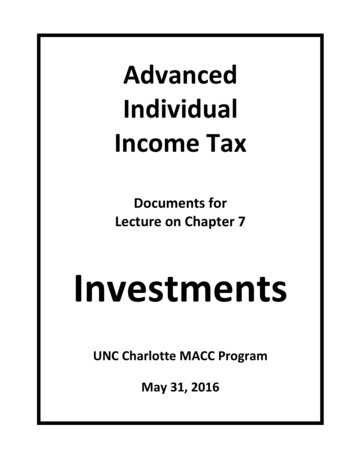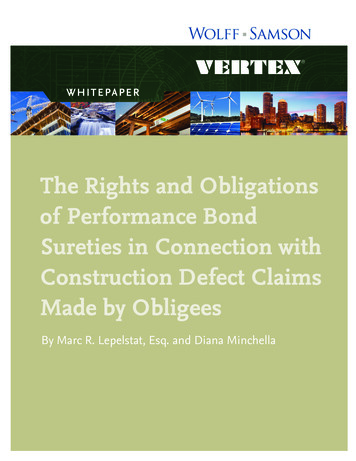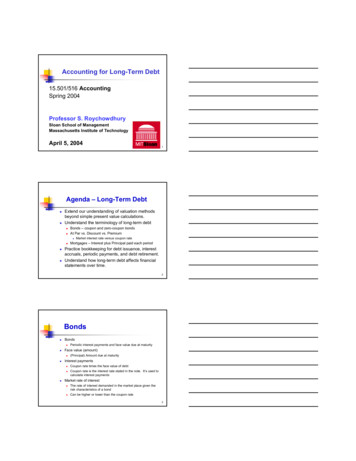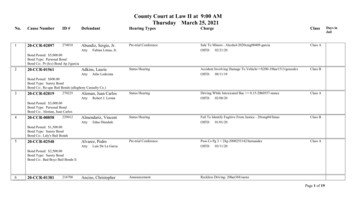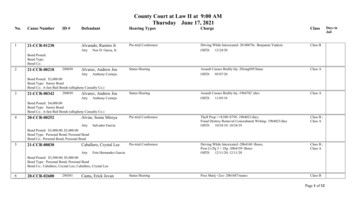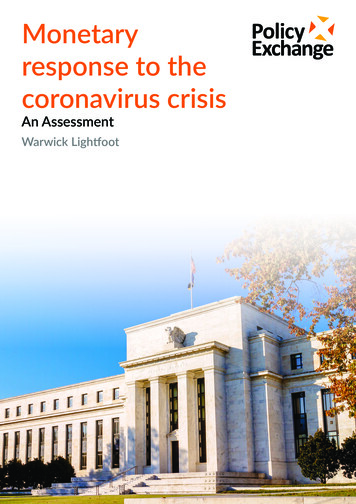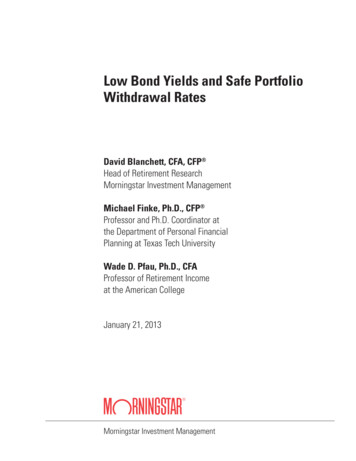
Transcription
Low Bond Yields and Safe PortfolioWithdrawal RatesDavid Blanchett, CFA, CFP Head of Retirement ResearchMorningstar Investment ManagementMichael Finke, Ph.D., CFP Professor and Ph.D. Coordinator atthe Department of Personal FinancialPlanning at Texas Tech UniversityWade D. Pfau, Ph.D., CFAProfessor of Retirement Incomeat the American CollegeJanuary 21, 2013Morningstar Investment Management
Executive Summary3 Yields on government bonds are well below historical averages. These low yields will have a significantimpact for retirees, who tend to invest heavily in bonds, because portfolio returns in the earliest yearsof retirement have a larger impact on the likelihood that a retirement income strategy will succeed thanreturns later in retirement; this is known as sequence risk.3 The majority of research on sustainable withdrawal strategies has used a stochastic (Monte Carlo) simu-lation process based on long-term averages, where the expected return of an asset class is the same foreach year of the simulation. While this approach is reasonable when markets are near long-term averages, we believe it is less useful when there is a significant and sustained deviation such as the currentlow bond yield market.3 In this paper we introduce a model that takes into account current bond yields and allows them to “drift”toward a higher value during retirement using an autoregressive model based primarily on historicalrelationships between asset classes. This approach can better replicate the actual bond returns a currentor near retiree can expect during retirement both now and in the future.3 Using this model, we find a significant reduction in “safe” initial withdrawal rates, with a 4% initial realwithdrawal rate having approximately a 50% probability of success over a 30-year period.3 We find a retiree who wants a 90% probability of achieving a retirement income goal with a 30-yeartime horizon and a 40% equity portfolio would only have an initial withdrawal rate of 2.8%. Such a lowwithdrawal rate would require 42.9% more savings if the retiree wanted to pull the same dollar valueout of the portfolio annually as he or she would get with a 4% withdrawal rate from a smaller portfolio. 2013 Morningstar. All rights reserved. This document includes proprietary material of Morningstar. Reproduction, transcription or other use,by any means, in whole or in part, without the prior written consent of Morningstar is prohibited. The Morningstar Investment Management division isa division of Morningstar and includes Morningstar Associates, Ibbotson Associates, and Morningstar Investment Services, which are registered investment advisors and wholly owned subsidiaries of Morningstar, Inc. The Morningstar name and logo are registered marks of Morningstar.Page 2 of 16
Low Bond Yields and Safe Portfolio Withdrawal RatesBond yields today are well below historical averages. This has significant implications because portfolioreturns in the earliest years of retirement have a larger impact on the likelihood that a retirement incomestrategy will succeed than returns later in retirement. The majority of research on sustainable withdrawalstrategies has used a stochastic (Monte Carlo) simulation process based on long-term averages, wherethe expected return of an asset class is the same for each year of the simulation. While this approach isreasonable when markets are near long-term averages, we believe it is less useful when there is a significant and sustained deviation such as the current low bond yield market.In this paper, we introduce a model that takes into account current bond yields and allows them to “drift”toward a higher value during retirement using an autoregressive model. This approach can better replicatethe actual bond returns a current or near retiree can expect during retirement both now and in the future.Using this model, we find that a 4% initial real withdrawal rate has approximately a 50% probability of success over a 30-year period. This success rate is materially lower than past studies and has significantimplications on the likelihood of success for retirees today as well as how much those nearing retirementmay need to have saved to ensure a successful retirement.Bond Yields TodayThese are trying times for bond investors. The yield on 10-year government bonds is approximately 1.8%and the yield for the High Quality Market Corporate Bond Yield Curve at 10 years is approximately 3.2%.These are both considerably below long-term averages.Low bond yields have important implications for different types of investors, especially older investors,who tend to invest more conservatively than younger investors. This concept is depicted visually in Figure 1,which includes the median equity allocation for household’s financial assets (FIN), given different assetlevels and ages. 2013 Morningstar. All rights reserved. This document includes proprietary material of Morningstar. Reproduction, transcription or other use,by any means, in whole or in part, without the prior written consent of Morningstar is prohibited. The Morningstar Investment Management division isa division of Morningstar and includes Morningstar Associates, Ibbotson Associates, and Morningstar Investment Services, which are registered investment advisors and wholly owned subsidiaries of Morningstar, Inc. The Morningstar name and logo are registered marks of Morningstar.Page 3 of 16
Figure 1: Median Equity Allocations of Financial Assets by Age for Various Levels of Financial Assets80FIN 10kFIN 100k70FIN 500kEquity Allocation (%)60Poly.(FIN 10k)y 5E-06x2 - 0.0082x 0.8617R2 0.3450750Poly.(FIN 100k)40Poly.(FIN 500k)y -0.0003x2 0.0443x - 1.1079R2 0.090973020y -0.0003x2 0.0435x - 1.0217R2 0.3851810060657075808590 95Age of Head of HouseholdSource: 2010 Survey of Consumer FinancesA high allocation to low-yielding bonds limits a retiree’s ability to generate income from retirement wealth.Unfortunately for today’s retiree, there is a very strong historical relationship between bond yields andthe future returns realized by bond investors, even over prolonged periods. Figure 2 demonstrates the relationship between bond yields and the future average annualized total return of bonds using the IbbotsonIntermediate-Term Bond Index.Figure 2: Relationship Between Bond Yields and Future Average Annualized 10 Year Bond Return16Average Annual 10 Year FutureCompounded Bond Return (%)1412y 0.9466x 0.0084R² 0.92034108642002468101214 16Current Bond Yield (%)The historical relationship between bond yields in one period and the future average annualized totalreturn of bonds has been quite strong, with a coefficient of determination (R²) of 92.03%. This means thatthe current yield on bonds can describe 92.03% of the average annual 10-year future compounded bondtotal return. If we assume a current bond yield of 1% (which is slightly higher than the yield on the Ibbotson 2013 Morningstar. All rights reserved. This document includes proprietary material of Morningstar. Reproduction, transcription or other use,by any means, in whole or in part, without the prior written consent of Morningstar is prohibited. The Morningstar Investment Management division isa division of Morningstar and includes Morningstar Associates, Ibbotson Associates, and Morningstar Investment Services, which are registered investment advisors and wholly owned subsidiaries of Morningstar, Inc. The Morningstar name and logo are registered marks of Morningstar.Page 4 of 16
Intermediate-term Government Bond Index as of December 2012), the average annualized bond total returnover the next 10 years is expected to be 1.8% using the linear regression model in Figure 2. This returnis almost 4% less than the 5.5% average annual return on the Ibbotson Intermediate-Term Government BondIndex from 1930 to 2011.While rising bond yields would result in higher returns for new bond investors, it would negatively affectthose currently holding bonds as the values of their low-yield bonds decline. One method to approximate theimpact of a change in interest rates on the price of bonds is to multiply the bond’s duration by the changein interest rates times negative one. For example, if interest rates increase by 2%, a bond with a duration offive years (the approximate current duration of the Barclays Aggregate Bond Index) would decrease by 10%.The impact on bonds with longer durations would be even more extreme.While there is a negative relationship between bond yield changes and bond returns, there is also a slightnegative relationship between the change in bond yields and the return on stocks. Figure 3 includes the real(inflation-adjusted) annual stock and bond returns for different historical changes in interest rates. Whilethe R² between changes in bond yields and the subsequent real return on stocks has been relatively small(5.91%), there is still a negative relationship. This negative relationship implies stock returns may be lowerin the foreseeable future as well.Figure 3: Real Stock and Bond Returns in Different Bond Yield Change Environments60BondsStocksLinear BondsAnnual Real Return (%)40y -5.2538x 0.0813R² 0.0591Linear Stocks200-20y -3.9986x 0.0219R² 0.2869-40-3-2-10123 4Annual Change in Bond Yield (%)Why Return Sequence MattersRetirement income portfolios are sensitive to poor portfolio returns early in retirement - a concept knownas sequence risk. Figure 4 illustrates differences in the real growth of a portfolio with an initial balance of 1,000, assuming a 5% initial withdrawal rate when early returns are favorable and unfavorable. 2013 Morningstar. All rights reserved. This document includes proprietary material of Morningstar. Reproduction, transcription or other use,by any means, in whole or in part, without the prior written consent of Morningstar is prohibited. The Morningstar Investment Management division isa division of Morningstar and includes Morningstar Associates, Ibbotson Associates, and Morningstar Investment Services, which are registered investment advisors and wholly owned subsidiaries of Morningstar, Inc. The Morningstar name and logo are registered marks of Morningstar.Page 5 of 16
Figure 4: Sequence Risk2,500ForwardBackwardReal Portfolio Value ( )2,0001,5001,0005000197119751979198319871991 1995YearFor the Forward scenario in Figure 4, the individual is assumed to retire on December 31, 1971. By the endof the 24th year (December 31, 1995), the portfolio would be exhausted and no longer able to fund the income goal of the retiree. If, however, we use the same real returns but assume the retiree would experiencethem in reverse (the Backward scenario), the portfolio would still have a healthy balance (in fact, higherthan the initial investment) by the end of the 24th year. Although the average annual return of the simulationsis identical, the outcomes are very different.The vast majority of models used to determine sustainable initial withdrawal rates from a portfolio usea single set of long-term values (e.g., returns, standard deviation, correlations) for the entire simulation.The values are either historical (e.g., based on a set of indices) or forward looking. The obvious problem withthis approach is that it assumes the returns an investor is able to achieve are equally likely over the entireretirement period. In other words, the returns from one period to another do not show momentum or serialcorrelation. While this may generally be the case for equities, it is not the case with fixed income securities.While the average annual arithmetic return on the Ibbotson Intermediate-Term Government Bond Index from1930 to 2011 was 5.5%, the interest rate available on an intermediate-term government bond today iscloser to 2.0%, which is 3.5% lower than the historic average. An analysis that assumes an average bondreturn of 5.5% in the first year (with a 6.5% standard deviation) will significantly overestimate early retirement portfolio returns.The approach taken in this paper assumes that bond yields will eventually revert toward their long-termaverages, but reflects the actual yields available to investors today for the first years of the simulation. Thismakes the analysis somewhat time sensitive (because bond yields are always changing), but provides a better estimate of the likely future bond returns available to investors within the context of interest rates today.Research on Sustainable Withdrawal RatesFor most practitioners, the methodology for generating a safe retirement income from an investment portfoliowas first addressed in Bengen (1994). Like most of the so-called safe withdrawal rate research that has fol- 2013 Morningstar. All rights reserved. This document includes proprietary material of Morningstar. Reproduction, transcription or other use,by any means, in whole or in part, without the prior written consent of Morningstar is prohibited. The Morningstar Investment Management division isa division of Morningstar and includes Morningstar Associates, Ibbotson Associates, and Morningstar Investment Services, which are registered investment advisors and wholly owned subsidiaries of Morningstar, Inc. The Morningstar name and logo are registered marks of Morningstar.Page 6 of 16
lowed, Bengen uses an outcomes metric similar to Roy’s (1952) Safety-First rule, which uses the probabilityof achieving a goal over some time period to define the optimal withdrawal amount from a portfolio.The term “initial withdrawal rate” is commonly used within portfolio withdrawal strategy research to describethe initial percentage withdrawn from the portfolio. This withdrawal amount is assumed to increase thereafter by inflation. For example, an initial portfolio with a 1 million balance and 4 percent initial withdrawalwould yield 40,000 in the first year. If inflation was 3 percent during the first year, the withdrawal for thesecond year would be 41,200 ( 40,000 * 1.03 41,200). This inflation adjusted withdrawal rate is deductedfrom the portfolio balance until retirement assets are exhausted. This represents a static approach to portfolio income because the income amount is determined initially (upon retirement) and is not revisited.Bengen (1994) recommends a 4 percent initial withdrawal rate from a portfolio made up of 50 percent stocksand 50 percent intermediate-term treasuries, is sustainable for a minimum of 33 years for retirees age 60–65.Bengen (2006) later coined the term SAFEMAX to describe the maximum inflation-adjusted withdrawalrate that would allow for at least 30 years of withdrawals without exhausting one’s savings during all of therolling periods available in the historical data.Later research by Cooley, Hubbard, and Waltz (1998), often called the Trinity study, generally confirmedBengen’s findings but increased the scope to different period lengths, initial withdrawal rates and types, andasset allocations. For example, Cooley, Hubbard, and Waltz (1998) note that if a retiree seeks a 75 percentprobability of success, a 4-to-5 percent initial withdrawal would be a good place to start (assuming portfoliosof 50 percent or more composed of large-company common stocks using historical data from 1926-1995).These findings have been affirmed by other research such as Milevsky, Ho, and Roberson (1997) and Jarrettand Stringfellow (2000), among others.Asset allocation can significantly affect a portfolio’s ability to sustain a given cash flow during retirement.Research by Ervin, Filer, and Smolira (2005), Tezel (2004), Cooley et al. (2003), and Kaplan (2005) demonstratethat portfolios with lower equity allocations tend to generate higher probabilities of ruin (in particular overretirement periods). These findings flow primarily from the use of historical market return averages in aMonte Carlo setting, since returns are generally assumed to be stationary and equities are assumed to havea higher return than bonds. Pfau (2011) used more forward-looking estimates when determining sustainablewithdrawal rates and notes significant differences in the safety of different withdrawal rates.MethodologyA model is constructed to generate returns for cash, bonds, and stocks, as well as inflation, that allows theexpected yield on bonds to drift upward toward their historical average over time. The initial interestrate (seed value) is assumed to be 2.5%, based on interest rates today. This is the approximate yield onthe Barclays Aggregate Bond Index as of January 1, 2013. Future bond yields are determined using anautoregressive model, detailed in Appendix 1, where the future bond yields are determined in reference tothe historical bond yield while including a random error.The returns experienced throughout the simulation are obviously going to be affected by the initial bond yield;however, the autoregressive model used for the analysis assumes that bond yields slowly revert back totheir long-term averages. Figure 5 demonstrates this concept and includes the different percentile bond yieldsfor years 0 through 40 within a given simulation. While the bond yield is the same (2.5%) in the beginning, 2013 Morningstar. All rights reserved. This document includes proprietary material of Morningstar. Reproduction, transcription or other use,by any means, in whole or in part, without the prior written consent of Morningstar is prohibited. The Morningstar Investment Management division isa division of Morningstar and includes Morningstar Associates, Ibbotson Associates, and Morningstar Investment Services, which are registered investment advisors and wholly owned subsidiaries of Morningstar, Inc. The Morningstar name and logo are registered marks of Morningstar.Page 7 of 16
the median yield across scenarios drifts toward its long-run average as the simulations progress. The actualyields experienced within each year of each simulation are going to drift through time, but on average themodel assumes that yields are stationary (i.e., mean reverting).Figure 5: Model Yield Convergence10Percentile5th25th8MedianBond Yield (%)75th695th42005101520253035 40YearTable 1 includes the returns, standard deviation, and correlations for the different modeling componentsfor the 30th year of a given simulation. These 30th year values can be viewed as the long-term assumptions of the model. We base our model primarily on the long-term annual returns, and relationships,between different asset classes. For our analysis we use 30-day Treasury Bills as the proxy for cash, theIbbotson Intermediate-Term Government Bond Index as a proxy for Bonds, and the S&P 500 Index as aproxy for stocks. We make a few subjective adjustments to make the expected returns look more similarto Ibbotson’s 2012 long-term capital market forecasts. The most significant adjustment was a reductionin the assumed return for equities.Table 1: Returns, Standard Deviations, and CorrelationsCash TR (%)Bond TR (%)Return3.025.14Bond Yld (%) Stock TR (%) 5.01Inflation (%)Standard Deviation2.336.222.31Cash TR1.000.240.88-0.02 0.45Bond TR0.241.000.290.11 -0.10Bond Yld0.880.291.000.00 0.28Stock TR-0.020.110.001.00 -0.08Inflation0.45-0.100.28-0.08 1.009.89 3.1419.68 2.71CorrelationsThe historical returns on U.S. stocks have been considerably higher than the equity returns of othercountries. For example, Dimson, Marsh, and Staunton find that the average annual inflation-adjustedgeometric (i.e., compounded) return of U.S. stocks from 1900 to 2011 was 7.26%. In contrast, the 2013 Morningstar. All rights reserved. This document includes proprietary material of Morningstar. Reproduction, transcription or other use,by any means, in whole or in part, without the prior written consent of Morningstar is prohibited. The Morningstar Investment Management division isa division of Morningstar and includes Morningstar Associates, Ibbotson Associates, and Morningstar Investment Services, which are registered investment advisors and wholly owned subsidiaries of Morningstar, Inc. The Morningstar name and logo are registered marks of Morningstar.Page 8 of 16
average annual real geometric return for equities in France was 3.06%, versus 4.24% for Switzerland,and 5.33% for the United Kingdom.While it is impossible to determine whether or not equities in the United States will continue to outperform other countries, in order to be conservative, the forecasted equity return is reduced in the model.From January 1926 to December 2011, the average annual arithmetic return for the S&P 500 was11.77%. This return is reduced by 2.0% so that the average expected arithmetic return for equitiesgoing forward is 9.77% (which is slightly different than the value in Table 1, because the Table 1 valueis the average across the simulations). This was accomplished by reducing the intercept in the returnmodel for equities.Each scenario in the analysis is based on a 10,000-run Monte Carlo simulation. Taxes and Required Minimum Distributions (RMDs) from the portfolio are ignored. The analysis assumes a 1.0% fee, or negativealpha, that is deducted from the portfolio value annually. This fee is included to account for unavoidableretirement portfolio expenses paid by the investor (e.g., mutual fund fees, advisor fees,account fees, etc.) for investment management.The primary metric used to relay the risk of different initial withdrawal rates is the probability of success.The probability of success is the percentage of runs that are able to successfully achieve the target cashflow for the respective period. While the probability of success is an imperfect measure because it doesnot provide information about the magnitude of failure, it is the most prominent metric in withdrawalrate research and relied upon by advisors to illustrate the risk of a given withdrawal rate and retirementportfolio strategy.ResultsAs noted in the Literature Review section, there is considerable research noting the safety of a 4%initial withdrawal rate. We find the relative safety of a 4% initial withdrawal rate may not be safein a low yield environment. Figure 6 includes the probability of success for various initial withdrawalrates for a 40% equity portfolio from 10 to 40 years.Figure 6: Probabilities of Success for Various Initial Withdrawal Rates for a 40% Equity Portfolio100InitialWithdrawal Rate3%Probability of Success (%)804%5%6%6040200101520253035 40Years 2013 Morningstar. All rights reserved. This document includes proprietary material of Morningstar. Reproduction, transcription or other use,by any means, in whole or in part, without the prior written consent of Morningstar is prohibited. The Morningstar Investment Management division isa division of Morningstar and includes Morningstar Associates, Ibbotson Associates, and Morningstar Investment Services, which are registered investment advisors and wholly owned subsidiaries of Morningstar, Inc. The Morningstar name and logo are registered marks of Morningstar.Page 9 of 16
We note the probability of success for a 4% initial withdrawal rate over a 30-year period for a 40%equity portfolio to be 48.2%, or slightly less than a coin flip. This is a considerably lower probability ofsuccess than what is noted in past research, which has tended to be above 80%. This result stemsfrom three key differences in this study versus past studies (especially those that have used purelyhistorical data). First, we use a model that incorporates the actual yields available to retirees today (thatconverges towards the long run expectation, on average). Second, we reduce the expected arithmeticreturn on equities by 2.0% (to 9.77%) to reflect a more realistic forecast for U.S. equities. Third, weassume a fee of 1.0% as a proxy for the asset management fees that are likely to be paid by an investor.Given the results shown in Figure 6, an important question would be; what is a safe initial withdrawalrate given the assumptions of this model? This information is included in Table 2, which notes the initialwithdrawal rates for various equity allocations, retirement periods, and probabilities of failure. Forexample, if a retiree with a 20% equity allocation wanted to plan for a 30-year time horizon and wanteda 90% probability of success, the initial withdrawal rate would be 2.7%.Table 2: Initial Withdrawal Rates for Various Equity Allocations, Retirement Periods, and Probabilities of SuccessRetirement Period (Years)152025303540Probability ofSuccess (%)20% Equity .11.8 .53.260% Equity AllocationProbability ofSuccess (%)1540% Equity Allocation80% Equity Table 2 has important implications for both existing retirees and those approaching retirement. There ciprocal of the initial withdrawal rate is the amount an individual must have saved to achieve anincome goal. For example, if a retiree wanted a 4% initial withdrawal rate, he or she would need a portfolio that was 25 times (1 / 4.0% 25) the annual income he or she desires in retirement. In contrast,if the initial withdrawal rate decreases to 3.0%, then the amount the retiree must save in order towithdraw the same annual dollar amount as in the 4.0% example increases to 33.33 times the targetincome amount. This may seem counterintuitive, but the larger the portfolio, the smaller the withdrawal rate required to provide the target annual income.While the difference between a 3.0% initial withdrawal rate and a 5.0% initial withdrawal rate maynot seem material, the 3.0% initial withdrawal rate requires 66.7% more savings than the 5.0% initialwithdrawal rate to produce the same annual income. One way to reduce the required savings amount 2013 Morningstar. All rights reserved. This document includes proprietary material of Morningstar. Reproduction, transcription or other use,by any means, in whole or in part, without the prior written consent of Morningstar is prohibited. The Morningstar Investment Management division isa division of Morningstar and includes Morningstar Associates, Ibbotson Associates, and Morningstar Investment Services, which are registered investment advisors and wholly owned subsidiaries of Morningstar, Inc. The Morningstar name and logo are registered marks of Morningstar.Page 10 of 16
would be to potentially take on more risk during retirement by increasing allocation to equities. Unfortu nately, increasing portfolio risk does not have a material impact. For example, the initial withdrawal ratefor a 20% equity portfolio with a 90% probability of success for a 30-year retirement period is 2.7%.If the retiree increased the equity portion of the portfolio to 60% and lowered the probability of successto 80%, he or she could only raise the initial withdrawal rate to 3.2%. This would require 18.5% lesssavings, but would subject the retiree to considerably more market risk, which is something that is notcaptured in the probability of success metric.ConclusionsThis paper introduced a model that takes into account current bond yields when determining the probability of success for different initial withdrawal rates over different time periods and for differentequity allocations. Using a model that incorporates how bond yields are likely to move (or drift) throughtime is a better approach to modeling returns retirees are likely to experience than assuming thesame average return for each year of the simulation as in previous studies. This is especially importantbecause the order of returns experienced during retirement can significantly affect the likelihood ofa retiree achieving his or her income goal (something known as sequence risk).We find that a 4% initial withdrawal rate has approximately a 50% probability of success over a 30-yearperiod. This success rate is much lower than past studies, which have typically noted a probabilityof success above 80%. This has significant implications on the likelihood of success for retirees todayas well as how much those nearing retirement need to have saved to ensure a successful retirement.For example, a retiree who wants a 90% probability of achieving a retirement income goal with a30-year time horizon and a 40% equity portfolio would only have an initial withdrawal rate of 2.8%.Such a low withdrawal rate would require 42.9% more savings if the retiree wanted to pull the same dollar value out of the portfolio annually as he or she would get with a 4% withdrawal rate froma smaller portfolio. 2013 Morningstar. All rights reserved. This document includes proprietary material of Morningstar. Reproduction, transcription or other use,by any means, in whole or in part, without the prior written consent of Morningstar is prohibited. The Morningstar Investment Management division isa division of Morningstar and includes Morningstar Associates, Ibbotson Associates, and Morningstar Investment Services, which are registered investment advisors and wholly owned subsidiaries of Morningstar, Inc. The Morningstar name and logo are registered marks of Morningstar.Page 11 of 16
ReferencesBengen, William P. 1994. “Determining Withdrawal Rates Using Historical Data.” Journal of FinancialPlanning, vol. 7: 171–180.Bengen, William P. 2006. “Baking a Withdrawal Plan ‘Layer Cake’ for Your Retirement Clients.” Journalof Financial Planning, vol. 19, no. 8: 44-51.Cooley, Philip L., Carl M. Hubbard, and Daniel T. Waltz. 1998. “Retirement Savings: Choosing a Withdrawal Rate that is Sustainable.” Journal of the American Association of Individual Investors, vol. 20:16–21.Cooley, Philip L., Carl M. Hubbard, and Daniel T. Waltz. 2003. “A Comparative Analysis of RetirementPortfolio Success Rates: Simulation versu
Low Bond Yields and Safe Portfolio Withdrawal Rates David Blanchett, CFA, CFP Head of Retirement Research Morningstar Investment Management Michael Finke, Ph.D., CFP
